Figure 5. MRNN achieves high-performance under ‘ideal' conditions.
(a) We compared cursor control using the MRNN (red) trained from many data sets up through the previous day to the FIT Sameday (blue) trained from data collected earlier the same day, without any artificial challenges (that is, no electrodes dropped or stale training data). Cursor trajectories are shown for eight representative and consecutive centre-out-and-back trials of the Radial 8 Task. Grey boxes show the target acquisition area boundaries, and the order of target presentation is denoted with green numbers. For comparison, cursor trajectories under arm control are shown in grey. From dataset R.2014.04.03. (b) Mean distance to target, across all Radial 8 Task trials under these favourable conditions, as a function of trial time using each cursor-control mode. Thickened portions of each trace correspond to ‘dial-in time', that is, the mean time between the first target acquisition and the final target acquisition. These MRNN and FIT Sameday data correspond to the drop 0 electrodes condition data in Fig. 3, and include 4,094 (3,278) MRNN trials and 4119 (3,305) FIT Sameday trials over 9 (8) experimental days in Monkey R (L).

